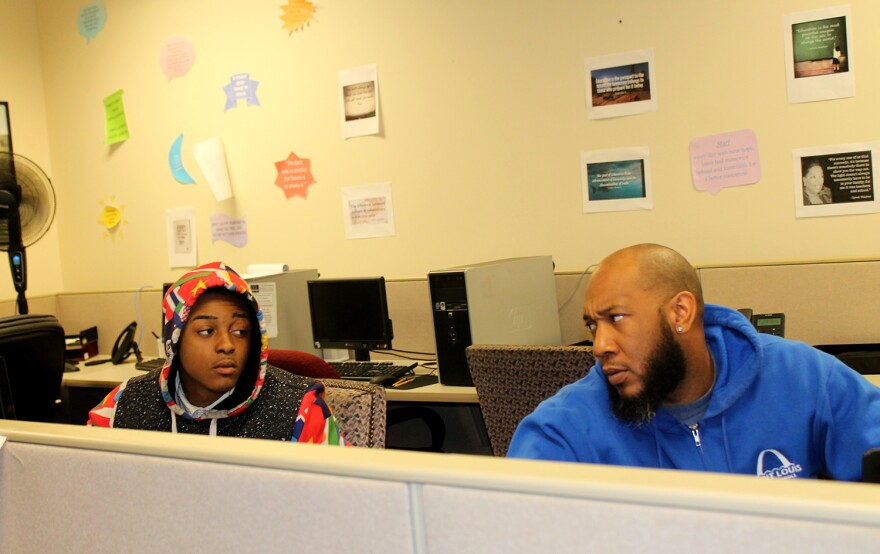Cedric Deshay has seen a lot in his 17 years. His dad died when he was a baby, followed by his mom when he was 13. Gun violence plagues his northeast St. Louis neighborhood; a recent killing was three houses down.
"I was falling behind in classes, falling asleep in class and stuff because of what was going on at home,” he explained. It was to the point that when his senior year began in August, Cedric was at risk of dropping out.
But with the help of a new school operated jointly by St. Louis Public Schools and the city’s job agency, he’s expected to graduate by April at the latest.
The school — Workforce High — uses the same online curriculum as the district’s three alternative schools and four credit-recovery programs. But some expertsquestion whether at-risk students are learning what they need to by watching video lessons and taking online quizzes at a rapid pace.
Workforce High is designed to boost the newly re-accredited district’s on-time graduation rate, which in 2016 was about 73 percent. By comparison, the national graduation rate was about 83 percent in 2015, the latest year data is available. Missouri’s average graduation rate in 2016 was 88 percent.
Workforce High, a product of the district and the St. Louis Agency on Training and Employment (SLATE), gives the 20 students like Cedric extra support and access to help with their lessons 24 hours a day. That’s right: one of SLATE's education mentors will meet Workforce High students at the SLATE computer lab that serves as their classroom day or night, as long as they make arrangements in advance.
On a recent day, curriculum instructor Sylvester McClain checked in with Cedric to make sure he's staying on track to graduate, encouraging him to take his U.S. Constitution test.
“When I came here it was better because I was finishing classes one on one,” Cedric said.
“Do you want to take it tomorrow?” McClain asked. “You might as well take it now and see where you stand. If you pass it you pass it. If you don’t, you take it again next week. You can take it as many times as you want to.”
Cedric will likely earn eight or nine credits online this year, at least two more credits than students usually earn in a year. (The state requires students to earn at least 24 credits to graduate from high school.)
That pace should allow him to graduate no later than April. He’s talking to a recruiter about joining the Air Force.

At what cost?
But the speed of his progress — and online courses in general — begs the question: Are students learning as much as they would in a traditional classroom?
Jessica Heppen with the nonpartisan, nonprofit American Institutes for Research has studied mentoring and credit recovery programs in urban schools.
While studying a credit recovery class in Chicago,Heppen found that students were more likely to pass an in-person Algebra I class, but that the online curriculum took the same amount of time to complete.
“Some online courses that are used in rapid credit-recovery models — like quick, get the credits back — probably are watered down,” Heppen said, adding that sometimes students find online credit-recovery classes more difficult because the course work is too advanced.
Heppen said it’s clear more students are graduating with the help of credit recovery courses, but there hasn’t been enough research to determine whether the students are learning what they need to know to be prepared for college or a career.
“It’s just an open question about how much that matters, or what they really need are stepping stones to get to what’s next in their lives,” Heppen said.
Her research also found that students who said they received a lot of support from the teacher monitoring the class fared better.
One-on-one work
It’s hands-on support that sets Workforce High apart, says Alice Prince, who helps oversee the school.
"It’s the exact same rigor,” said Prince, a director at SLATE. “I ask our students what is the difference, and they say ‘Well it’s a family atmosphere. The education mentors care if you get it or not.”
She’s also involved with the job agency’s Prison to Prosperity program, which she believes helps with the graduation rate, too.
“There is a direct correlation between a young black male obtaining a high school diploma versus one going to jail for an assault, murder or theft,” she said.
Jeavon Gill, 18, was in jail last year on a charge of second-degree robbery. Studying at Workforce High through the Prison to Prosperity program helped get his charges dropped, a SLATE administrator said.
“I had got caught up in the wrong crowd. Got mixed up,” Gill said.
He likes Workforce High because he can work at his own pace.
“I started flying through the classes, like that first month, I passed like two classes. And then once January came I passed another class. I just passed my trig and my advanced algebra. Only got three classes left,” said Gill, who wants to study nursing after graduation.
Loading...
Follow Camille on Twitter: @cmpcamille
An earlier version of this story misspelled Jeavon Gill's first name in photo captions. It also misspelled Sylvester McClain's first name.





